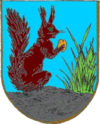Krasnoyilsk
| Krasnoyilsk | ||
| Красноїльськ | ||

|
|
|
| Basic data | ||
|---|---|---|
| Oblast : | Chernivtsi Oblast | |
| Rajon : | Storozhynets district | |
| Height : | 448 m | |
| Area : | Information is missing | |
| Residents : | 9,122 (2004) | |
| Postcodes : | 59022 | |
| Area code : | +380 3730 | |
| Geographic location : | 48 ° 1 ' N , 25 ° 34' E | |
| KOATUU : | 7324555400 | |
| Administrative structure : | 1 urban-type settlement | |
| Mayor : | Ovidiu Mitric | |
| Address: | вул. Штефан чел Маре (vol. Ștefan cel Mare) 157 59022 смт. Красноїльськ (Krasnojilsk) |
|
| Statistical information | ||
|
|
||
Krasnojilsk ( Ukrainian Красноїльськ ; Russian Красноильск Krasnoilsk , Romanian Crasna Ilschi also Crasna ; German Krasna Ilski ) is an urban-type settlement in the Ukrainian Oblast of Chernivtsi . It is located in a valley south of the city of Storoschynez , 8 kilometers north of the border with Romania , about 39 km southwest of Chernivtsi in northern Bukovina .
history
The settlement was first mentioned in writing in the first half of the 15th century. In the deed of July 15, 1431, half of the property on the left side of the Sereth was assigned to the boyar Stan Cupcici, and that on the right side of the river to the Putna monastery .
In 1652, through the family connection with the Chancellor of Moldova Gavrilaş Mateiaş , the property passed to the Ursachi family of boyars. The tall sulger Dumitraşcu Ursachi sold his shares on May 1, 1696, to Alexander de Ilschi (Jelsky). The village belonged to the Principality of Moldova until January 1775 .
After the Bucovina was occupied by neutral Austria towards the end of the Russo-Ottoman War (1768–1774) in 1774 , this was confirmed in the peace treaty of Küçük Kaynarca in 1775 , officially as thanks for Austria's "intermediary services" between the war opponents. As a result, Krasna Ilski was part of Austria, first in the Kingdom of Galicia and Lodomeria , and from 1849 in the newly founded crown land Duchy of Bukovina .
On March 15, 1783, the Austrian commission for the division of property in Bukovina , headed by Johann Thaddäus Anton Peithner von Lichtenfels, confirmed that half of the village belonged to Alexander de Ilski and his brother-in-law Miron Gaffenko, the other half to Putna Monastery .
From 1786 on, German farming families from Bohemia settled in the village, who were later to found the Althütte colony (Romanian Huta Veche; Ukrainian Стара Красношора). The first glassworks in Bukovina was built there in 1793, and four more were built by 1821.
On January 14, 1787, Basil Ritter von Wassilko acquired a large part of Crasna Ilschi. There he married on December 15 that year Nastassia (Anastasia), daughter of Alexander von Ilschi, who only owned a quarter of the village.
In the middle of the 19th century there was further settlement of German settlers in the existing location, which was predominantly inhabited by Romanians and is still today. The Germans left the place in the course of the population exchange in 1940 (see Bukowinadeutsche ).
After the end of the First World War in 1918, the place became part of Romania (in the Storojine Kreis district ), in the course of the annexation of Northern Bukovina on June 28, 1940 it became part of the Soviet Union (between 1941 and 1944 it became part of Romania) and has been a part since 1991 Of Ukraine. In 1968 it was elevated to the status of an urban-type settlement, before the northern village of Krasnoputna (German Krasna Putna ) was incorporated.
population
- 1930: 3,187 inhabitants in Crasna Ilschi and 1,948 in Crasna Putnei (population census)
- 1989: 7,769 (census)
- 2001: 9,142 (census)
- 2007: 9,122 (estimate)
In the 1989 census, 7,049 citizens, over 90 percent of the total population, declared themselves Romanians. Furthermore, 467 Ukrainians, 148 Russians, 46 Poles, 7 Jews and 22 other ethnic groups lived in the village.
Individual evidence
- ↑ Teodor Balan, Prof. univ., Documente bucoviniene, Vol. 1, Institutul de arte grafice şi editură "Glasul Bucovinei", Cernăuţi 1933, p. 25 f.
- ↑ Teodor Balan, Prof. univ., Documente bucoviniene, Vol. 3, Institutul de arte grafice şi editură "Glasul Bucovinei", Cernăuţi 1937, p. 71
- ↑ http://www.monitorulsv.ro/Povestea-asezarilor-bucovinene/2011-05-27/CRASNA-I
- ↑ Willi Kosiul: “The Bukowina and their Buchenlanddeutschen”, Volume 1, Reimo-Verlag, Oberding 2011, p. 263 ff.
- ↑ http://www.monitorulsv.ro/Povestea-asezarilor-bucovinene/2011-05-30/CRASNA-II
- ↑ Villages of Bukovina ( Memento of the original from January 10, 2007 in the Internet Archive ) Info: The archive link was inserted automatically and has not yet been checked. Please check the original and archive link according to the instructions and then remove this notice.
- ↑ Dr. Ion Popescu - Cap. II. Populația românofonă din Regiunea Cernăuți la sfârșitul perioadei sovietice (Nordul Bucovinei, nordul Basarabiei și Ținutul Herței) ( Memento of the original from January 5, 2012 in the Internet Archive ) Info: The archive link has been inserted automatically and has not yet been checked. Please check the original and archive link according to the instructions and then remove this notice. (PDF; 438 kB)
literature
- Teodor Bălan , Prof. univ., Documente bucovinene, Vol. 1, Institutul de arte grafice şi editură "Glasul Bucovinei", Cernăuţi 1933.
- Teodor Bălan, Prof. univ., Documente bucovinene, Vol. 3, Institutul de arte grafice şi editură "Glasul Bucovinei", Cernăuţi 1937.
- Laurențiu Dragomir - Crasna. Un colț de eternitate românească din Bucovina. Monograph etnografică și istorică, Editura Coralia, București, 2004, ISBN 973-86976-0-3 .


